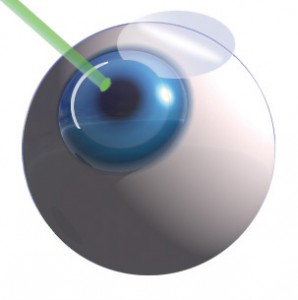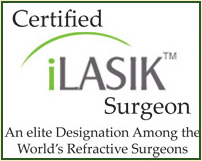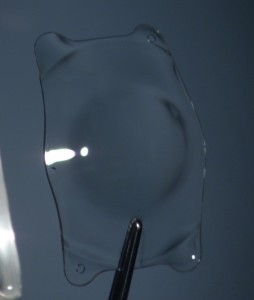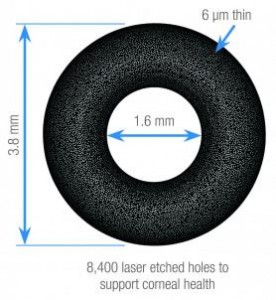LASIK, Visian & Kamra
LASIK (laser-assisted in situ keratomileusis) is a safe, reliable and painless way to improve vision and reduce or eliminate the need to wear glasses or contact lenses. LASIK changes the way light is bent, or refracted, as it passes through the cornea so that it focuses properly on the retina and objects can be seen clearly. Custom LASIK individualizes your treatment to account for variability between patients leading to improved outcomes and safety.
 During the procedure, a thin flap on the surface of the cornea is created with a laser or automated microkeratome. Patients are given anesthesia so they can't feel the instruments. The flap is then lifted and an excimer laser beam reshapes the cornea's curvature to improve vision. The flap is then replaced and allowed to heal without the need for stitches.
During the procedure, a thin flap on the surface of the cornea is created with a laser or automated microkeratome. Patients are given anesthesia so they can't feel the instruments. The flap is then lifted and an excimer laser beam reshapes the cornea's curvature to improve vision. The flap is then replaced and allowed to heal without the need for stitches.
The entire procedure takes only a few minutes per eye and recovery is quick. Most patients will be able to drive and return to work the next day thus minimizing down time. Dr. Dornic is a fellowship trained LASIK surgeon having performed thousands of successful LASIK procedures. The Laser Eye Center of Carolina is one of the few facilities in the triangle to provide CustomVue wavefront-guided LASIK to provide the highest quality vision and minimize the risk of night time driving difficulties.
iLASIK
is a technological leap in LASIK technology. As LASIK technology evolved and improved, older techniques have been replaced with the iLASIK procedure. iLASIK is an all-laser, blade-free flap combined with the safety and effectiveness of wavefront that results in today’s premium vision correction procedure.
The technology used in the iLASIK procedure is very mature (the systems used today have been in use for years) and very safe. Doctors have been performing LASIK for a decade. Approximately 32 million LASIK procedures have been performed to date, making it the most common elective vision procedure in the U.S. In fact, all branches of the U.S. military and NASA recently approved LASIK for their servicemen and women, thanks to studies using iLASIK technology.
(the systems used today have been in use for years) and very safe. Doctors have been performing LASIK for a decade. Approximately 32 million LASIK procedures have been performed to date, making it the most common elective vision procedure in the U.S. In fact, all branches of the U.S. military and NASA recently approved LASIK for their servicemen and women, thanks to studies using iLASIK technology.
Dr. Dornic is the first triangle based ophthalmologist to perform the iLASIK procedure.
Steps of the iLASIK procedure:
- You get an extensive exam by Dr. Dornic
- Computers/software are used to make an individual blueprint of your eyes; this blueprint is used to drive your laser correction and is what gives you a truly customized result
- A laser is used to make a thin flap in your cornea You'll be given numbing drops so you won't feel pain
- This flap enables the surgeon to make the iLASIK correction
- A second laser is used to make the correction to your cornea, based on your unique vision/eye characteristics This correction is completely computer driven
- It's safe, fast and virtually painless
- You can have great vision without glasses or contacts
PRK
PRK or photorefractive keratectomy is one of the safest and most time-tested laser vision correction procedures available. Like LASIK, it reshapes the cornea to improve vision. It may be an option for patients who are not a candidate for the LASIK procedure.
In PRK the surgeon uses an excimer laser to vaporize a small amount of tissue from the top of the cornea. As with LASIK, nearsightedness, farsightedness and astigmatism all can all be corrected. Vision recovery is longer than with LASIK. Patients can expect scratchiness and blur for 3-7 days after the procedure. Drops are prescribed to help with discomfort.
CK (Conductive Keratoplasty)
Conductive Keratoplasty or CK is a safe, non-laser, non-cutting technique approved by the FDA to reduce or eliminate presbyopia or hyperopia. It is generally appropriate for patients over the age of 40 who have a need for reading glasses. Instead of a scalpel or a laser, CK releases radiofrequency (RF) energy through a probe as thin as a strand of human hair, treating your vision condition without cutting or removing tissue. The controlled release of RF energy in a circular pattern shrinks tissue in the cornea to reshape it, improving the way the eye focuses light.
CK is very safe and may be the preferred method to correct some patients who are not good LASIK candidates. It takes less than five minutes per eye and uses only a topical anesthetic. Post-operative discomfort is minimal and vision improves almost immediately.
Implantable Contact Lenses (ICL)
 ICL also known as Phakic intraocular lenses (IOL’s) can correct a wide range of vision errors by inserting an implant (much like a contact lens) in front of the natural lens of the eye. This technique is similar to cataract lens surgery, but the natural lens remains in place so the eye’s natural focusing ability is preserved. An implantable contact lens is beneficial because it becomes a permanent fixture of the eye, avoiding time consuming maintenance. Implantable contact lenses, such as Visian and Verisyse also do not get lost, foggy or have to be replaced like glasses or contact lenses. ICL procedures are being used on patients with higher amounts of nearsightedness or in patients who may not be candidates for LASIK or PRK. Unlike laser vision correction procedures that permanently change your vision, it is possible to later remove an ICL. The implantable contact lens is a quick (15 minute per eye) procedure with a speedy recovery. Most patients will be able to perform their normal day to day activities after a comfortable 1-2 day recovery period.
ICL also known as Phakic intraocular lenses (IOL’s) can correct a wide range of vision errors by inserting an implant (much like a contact lens) in front of the natural lens of the eye. This technique is similar to cataract lens surgery, but the natural lens remains in place so the eye’s natural focusing ability is preserved. An implantable contact lens is beneficial because it becomes a permanent fixture of the eye, avoiding time consuming maintenance. Implantable contact lenses, such as Visian and Verisyse also do not get lost, foggy or have to be replaced like glasses or contact lenses. ICL procedures are being used on patients with higher amounts of nearsightedness or in patients who may not be candidates for LASIK or PRK. Unlike laser vision correction procedures that permanently change your vision, it is possible to later remove an ICL. The implantable contact lens is a quick (15 minute per eye) procedure with a speedy recovery. Most patients will be able to perform their normal day to day activities after a comfortable 1-2 day recovery period.
Kamra Inlay
Did the years take away your great vision? Are you finding yourself dependent on reading glasses or bifocals? Presbyopia is the name for the condition that causes a loss of focusing ability as we age and up until recently, there has been no good solution to improve near vision without also dimishing distance vision. The KAMRA inlay is ideal for people who want to enjoy life without the constant frustrations of reading glasses. It provides a natural range of vision -- from near to far -- without blurry zones. In addition, it offers long-term performance that delivers clear near vision even as presbyopia progresses. The Kamra Inlay has a unique design. It is microscopically small and thin. Just 3.8 mm in diameter with a 1.6 mm central opening, it rests comfortably and securely in the cornea. The central aperture enables focused light to reach the back of the eye and works like the f-stop in a camera. The Kamra procedure is not monovision: near vision is enhanced without sacrificing distance vision and with no loss of depth perception.
Some important benefits of the Kamra Inlay include:
Reduced need for reading glasses
Can often be performed on patients who have had LASIK, PRK or cataract surgery
The inlay generally cannot be detected by others when viewed straight on
Does not significantly hinder future vision exams or surgeries
KAMRA can be removed if needed
If you are over the age of forty with good distance vision but have noticed a deterioration in your near vision, the Kamra Inlay may be right for you.




